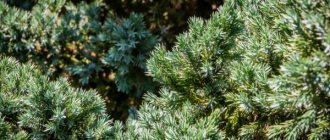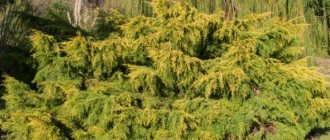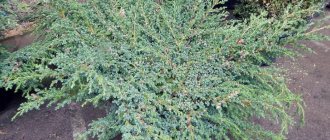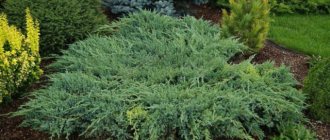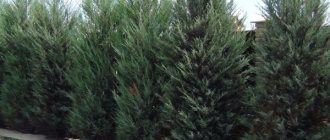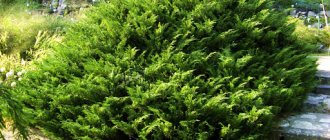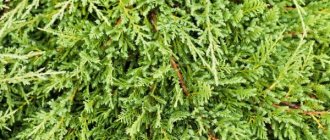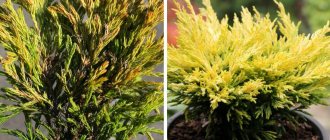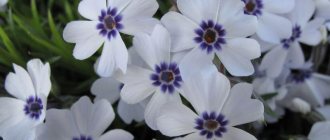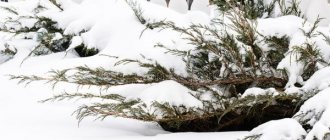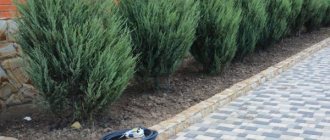Bushes and trees
0
374
Article rating
Kira Stoletova
One of the best decorative elements in garden landscape design is the Hibernica juniper. The evergreen plant was developed more than 200 years ago in Ireland, and has become widespread throughout the world. This is one of the most successful developments of breeders, which has become a unique variety of common juniper.
Features of growing juniper Hibernica
Common juniper Hibernika: history of variety creation
Juniper Hibernika: photo of the variety
This variety appeared in Ireland through crossing. Since the beginning of the 18th century, juniper began to actively spread, and became popular due to its beauty and elegance. Scientists became interested in this crop and decided to develop new varieties, and that’s how Hibernica turned out. Since juniper is a plant that tolerates frost well and can be grown in northern regions, it very quickly gained popularity in the Russian Federation. Now Hibernica is grown in many countries, used to decorate garden plots.
Common juniper Hibernika: variety description
Common juniper Hibernika: photo
The Hibernica variety is a fairly tall plant with an interesting foliage shape. Typically, this crop can reach up to 5 meters in height, with proper care and planting location. The interesting shape of the crown is an interesting feature of the variety; it looks like a column. The branches of the plant are pressed very tightly against the bark, therefore the diameter of the bush is small, on average 140 centimeters. It is worth noting that if you do not like the shape of the bush, you can easily adjust it. Not only the shape, but also the height of the plant, this can be done due to the fact that the plant is formed by a trunk.
Due to long-term cultivation in areas with a fairly cold climate, the variety has adapted to such temperatures. Therefore, it grows and develops well in areas with low temperatures. It can very often be found on the plots of many gardeners. Many people like this culture.
The variety is drought-resistant, but you shouldn’t tempt fate and completely forget about watering. With short-term drought, the plant does not experience stress, but with medium or long drought, the plant loses many of its functions. For example, it begins to change color, and instead of a beautiful emerald color, it turns out to be a dirty brown or sickly yellow color. These colors don't look very nice to say the least. Also, the plant slows down its growth and development as a whole, while these processes will be restored for another 7 days after a slight drought, so you should carefully monitor the soil moisture. If juniper grows in open ground, then it needs regular watering, but you cannot add excess moisture, as the root system may begin to rot, which will lead to lethargy of the plant, and ultimately death. The best option would be moist soil with some shade.
Hiberica is highly resistant to different temperatures, especially frost. The plant feels normal down to -35 degrees; at lower temperatures, development begins to slow down. After the annual shoots have frozen, it is necessary to begin restoring the crown; this is necessary only for this variety. Due to the fact that this is a hybrid, it needs to restore the crown, as many varieties recover after wintering.
Juniper Hibernica is a perennial plant that, with proper care and regular inspections, can grow on a gardener’s plot for about 90-110 years, depending on the climate. The variety does not require special care, but basic work must still be completed. The formation of foliage is not required, since the crown grows only a few centimeters annually.
Popular varieties
Juniper (Juniperus) is a genus of evergreen shrubs and trees of the Cypress family. Characteristics and description depend on the species, as well as the specific plant variety. The culture is valued for its decorative properties, phytoncidal properties, and use in pharmacology, cosmetology and folk medicine. Separate parts of some varieties can be used in cooking, as well as woodworking.
Some varieties of juniper have a columnar shape:
- ordinary;
- Virginian;
- rocky;
- Chinese.
Ordinary
Juniperus communis is a dioecious, sometimes monoecious shrub or tree up to 12 m high; male plants have a narrower crown than female ones. The bark is longitudinally peeling, dark grayish or brownish in color, the shoots are reddish-brown. Leaflets with parameters 1-1.5x0.7-7.5 cm, hard, spiny, have a shallow groove on top, 1 whitish stomatal stripe, shiny below.
Common columnar juniper is poisonous.
This coniferous species reproduces mainly by seeds and lives for about 600-700 years. Common columnar juniper is poisonous. The wood has high mechanical properties and is used for turning, carving, the production of toys and canes, and the production of juniper oil for external application. The culture is used in landscape design as a field-protective and soil-fixing plant.
Cone berries have been used in cooking and the food industry - they are part of spices and are suitable for liquor and vodka production, brewing, making gin and boletus. Common juniper has strong phytoncidal properties. The fruits are used for medicinal purposes.
Columnar varieties of this type of conifer:
- Constans Franklin;
- Columnaris;
- Sentinel;
- Wilsender Berg;
- compressa;
- Hibernica;
- Suecica;
- Suecica Nana.
Virginia
Juniperus virginiana - monoecious, sometimes dioecious trees up to 30 m high, trunk circumference up to 1.5 m. Needles are dark green, small, 0.1-0.2 cm in size. Cones up to 0.6 cm in diameter, ripen in the fall of the first year , hang on branches for a long time. The wood is resistant to rotting processes. Used in landscape design, production of cedar essential oil, and pencil making.
The needles are dark green, small, 0.1-0.2 cm in size.
Columnar varieties of Virginia juniper:
- Burkii;
- Glauca;
- Hillii;
- Princeton Sentry;
- Taylor.
Rocky
Juniperus scopulorum are dioecious shrubs or trees up to 15-20 m high, with a trunk 0.8-1.5 m in circumference. Young branches are 4-sided, 1.5 mm thick, bluish or light green. The leaves are often scale-like, with a blunt crown, dark or bluish green in color. The cones are 0.4-0.6 cm in diameter, spherical, dark blue in color with a bluish coating.
Rock columnar juniper is recommended to be planted in well-lit areas, sheltered from strong winds. The needles can withstand slight shading, but the lack of light reduces the decorative effect. The annual growth is approximately 12 cm. Coniferous species are susceptible to snowfall and have low winter hardiness.
Rock columnar juniper is recommended to be planted in well-lit areas, sheltered from strong winds.
Columnar varieties of rock juniper:
- Blue Angel;
- Blue Arrow;
- Skyrocket;
- Blue Saber;
- Greenspire;
- Medora;
- Sutherland.
Chinese
Juniperus chinensis is a shrub or tree up to 25 m high. The shoots are round, dark green, 1-2.5 mm thick. The needles are scale-like and needle-like. The cones are variable, spherical or elongated, first covered with a whitish coating, then brown, dark green, black. The fruits consist of 4-8 scales, the circumference of the cone is up to 0.9 cm.
Chinese juniper is slow growing. Frost-resistant, can withstand temperatures down to -30°C. It tolerates drought well, prefers nutritious fresh soil and sufficient air humidity, and is able to grow in urban conditions. This coniferous species is often used for growing bonsai trees.
Tolerates drought well, prefers nutritious fresh soil and sufficient air humidity.
Columnar varieties of Chinese juniper:
- Obelisk;
- Monarch;
- Columnaris;
- Mountbatten;
- Strict.
What does common juniper Hibernica look like?
What does common juniper Hibernica look like?
Hibernica is very beautiful in appearance. The variety has a regular column shape, elongated, thin, and quite compact. The branches of the plant are of medium size and have an interesting color, similar to emerald, mixed a little with burgundy. The burgundy tint appears only in sunlight; it will not be noticeable in the shade. The branches adhere tightly to the bark, so the juniper looks very slender; the foliage forms near the soil itself. There are small irregularities and scales on the bark. The shoots of the plant begin to grow from the center of the bush. The branches, which are only a year old, have an interesting olive color and grow only perpendicular to the ground, upward.
The needles also have an interesting shape, each has three sides and a point at the end, only it does not prick and cannot harm either an animal or a person. The needles are very soft and delicate and have different shades, ranging from gray to burgundy. The culture is an evergreen plant, not a deciduous plant, therefore, with the onset of autumn, the needles acquire a green-black color. The crown of the plant is very dense and does not have much space between the branches. The roots of this variety are very large and powerful; they can sink up to 6 meters into the soil.
Hibernica berries are medium in size. Depending on the stage of ripening they have different colors. For example, in the initial form they have a light green color, and in the final form they have a brown-black color.
Note: This variety can be eaten if necessary
Botanical description
The appearance of juniper depends on several factors.
The main ones:
- varietal affiliation;
- place of growth;
- climate.
However, all varieties have a number of features on the basis of which a general description can be drawn up. Using this information, you can easily distinguish juniper from other plants.
Check out Juniper Andorra Variegata.
Characteristics of juniper:
- attitude towards light - light-loving, drought-resistant;
- acceptable temperature conditions – –30…+40°С;
- Reproduction methods: seeds, cuttings, layering.
Family and genus of juniper
The vegetation is represented by the Juniper genus, the Cypress family. In Latin, juniper will be called Juniperus communis. The first descriptions of it are found in ancient Greek treatises and myths. At that time, its cultivation was practiced to produce medicine. Today, a total of more than 70 wild and ornamental species are known.
Shrub or tree, coniferous or deciduous
Juniper is a coniferous evergreen plant. In nature, both shrubby and tree forms are found. It all depends on the zone in which the heather will grow. In northern latitudes the vegetation is shrubs, in southern latitudes it is trees. The crown is cone-shaped or ovoid, sometimes with drooping shoots at the ends. Bushes can be erect or creeping. The juniper leaf is called a needle or scale.
Learn how to treat rust on juniper.
But these are leaves that have an elongated lanceolate shape, and not needles, like other conifers. The common juniper has needle-shaped leaf blades. They are triangular, rigid structure. They reach 1.5 cm in length and 1 mm in width. They are covered with a layer of waxy coating: it is this that gives different shades to the leaf blades - light green, bluish or golden.
Height
The height of the plant depends on what form it is presented in. For shrubs it varies between 1–3 m. For trees this figure is 8–15 m.
What kind of trunk does a juniper have?
The diameter of the shrubs can grow up to 0.8–2 m. The trunk of the tree has a thickness of 0.5–1 m. The bark is dark gray or gray-brown, vertically peeling. Reddish on the shoots.
Did you know? Cabinets made from juniper wood never harbor moths.
How juniper blooms
Flowering and pollination occur in May, and for specimens growing in northern latitudes - in June. In nature, there are monoecious (only male or only female flowers are formed) and dioecious (male and female flowers are formed on the same plant) forms. The male flower is a yellow spikelet, the female flower is a green bud. The main difference between juniper and other conifers is its fruits.
They are not cones, but cone berries. They reach 10 mm in diameter. They are painted bright blue when they reach full maturity and are covered with a waxy coating. Ripen for 3 years. Each fruit contains 2 or 3 trihedral, ovoid seeds. Cone berries have a spicy pine aroma. The taste is sweetish, juicy.
Important! Of all the varieties of juniper, only the common one is edible, but is not eaten in its raw form, but is used in the food industry for the production of seasonings, additives in tea and confectionery. All others are poisonous
What does juniper smell like?
Like all coniferous plants, heather exudes a pleasant pine scent. But it will still be different. The aroma of pine needles in this species is more subtle, with barely perceptible sweetish-woody notes. In varieties such as Kazatsky and Vonyuchy, the aroma is more pronounced. It is very harsh, even slightly unpleasant.
How many years does he live?
Juniper is a long-lived plant. Its maximum age is 600 years. The first fruiting is observed at 5–10 years. Abundant pine cone harvests appear every 3–5 years. Throughout its life cycle, the plant will bloom and bear fruit.
How to decorate an area with juniper
Why did Hibernica become popular? Firstly, because it is particularly unpretentious to care, and secondly, because it is very beautiful and elegant.
Various varieties of juniper gained momentum in the 19th century, when garden designers began to actively decorate their areas with them. The presence of this culture makes the territory more well-groomed, gentle and comfortable for you and your guests. Very often, the crop is planted in various pensions and holiday homes so that vacationers can relax and enjoy as much as possible.
A shrub with the correct shape can be used to decorate city streets, alleys and parks. Juniper is often used as a living fence. There are many different ways to decorate any area with these plants.
But the most popular ones in design are the following:
- Compositions made from juniper and low-growing conifer look very beautiful.
- Hibernica can be used as a tapeworm in the middle of an alley.
- The culture looks great if planted around the perimeter of any area.
- Can be planted along any building.
This variety goes well with plants that are yellow or orange. The combination of green and yellow or orange looks interesting and makes the interior of the site more interesting and attracts more attention.
You can create juniper and juniper combinations using different varieties. For example, using Hibernica with Variegata is very popular and is performed by many landscape designers. Due to the density of the crown, it can be shaped into different shapes, and pruning is very easy. Hibernica can be planted in the center of the garden and given a non-standard shape that will last for a long time, due to the fact that every year the growth is several centimeters.
A hedge, a combination with other varieties of juniper or with other plants in general, planting Hibernika juniper depends only on your imagination. After all, it can be planted with absolutely any plants and in any combinations.
Does the type of soil in which the variety will grow matter?
This variety is unpretentious to the soil, so it will take root well in any soil. Since the variety has a powerful root system, the variety does not care about the upper layers of the soil at all. A juniper is considered an adult after it is more than 10 years old. Young juniper needs soil that will be saturated with various beneficial substances, and the presence of a drainage system is also very important. Ideally, the soil should have low acidity; other criteria for juniper are not important.
The variety has average resistance to drought, so when planting it in open ground, it is necessary to take into account the location; it should be semi-shaded and free from drafts. With prolonged drought, the plant becomes lethargic and the color of the plant turns pale. Thanks to the small shadow that can be created by plants, trees or small buildings, the color of the needles does not fade, but remains just as rich. If the plant is planted in a place that is too dark, it will not develop and will die.
Note: The only plant that should not be near juniper is the apple tree, as it causes rust on the foliage of the crop.
Errors during cultivation
All problems when growing this conifer are associated with violation of the rules of planting and care:
If the planting is too thick and the timing is not met, the juniper often fades, turns yellow or grows poorly, so you need to strictly follow the rules and planting time. Due to excess or lack of moisture, nutrients, loosening, it loses strong immunity, decorativeness and dies.
It is important to adhere to the watering schedule, taking into account seasonal precipitation, and apply fertilizers on time at the above dosage. Regular inspection for damage by diseases and parasites, as well as timely measures taken will help maintain health and avoid death. To prevent burning of the needles in the spring, you should provide shade from the scorching sun, and from damping off in the winter - cover with breathable material (burlap or spruce branches). The absence of a drainage layer during planting, as well as planting in a wetland, is a sign of wilting and yellowing of the plant. The problem can be solved if you transplant the conifer to a new plot with deep groundwater.
Juniper Hibernica: description of preparing seedlings for planting
The seedling must meet certain criteria:
- He must be two years old.
- The seedling must be healthy and free of any cuts or damage.
- The trunk should be light green.
- The root system must be well developed, healthy and without damage.
- The plant must have needles.
Before planting, you need to treat the roots using a manganese solution, after which you need to place the root system in a solution of a growth stimulator, you can use Etamon.
The landing site must be prepared in advance. In 15 days it needs to be dug up, coarse sand added, it will serve as a drainage system, and also normalize the acidity of the area. You can make the soil lighter using peat humus and compost. The hole in which the plant will be planted must be dug according to the size of the measles system. In this case, there should be a distance along the edge. The depth also depends on the root system, it is calculated as follows, the distance of the root system to the root neck and then another 18-22 centimeters is added.
Reproduction
The description of a coniferous tree includes 2 methods of propagation - using cuttings and seeds.
The second method is less effective and is more often used by breeders to improve the qualities of a plant or obtain a new hybrid form. Therefore, it is worth dwelling in more detail on the first option.
Cuttings are the most universal method that gives good results. The propagation procedure is carried out in the spring.
Preparation of cuttings
In cloudy weather, apical woody cuttings are cut from a healthy adult plant. Cut with a sharp and sterile knife along with a piece of old wood.
Just above the heel, remove the bark and all the shoots in a section of 2-3 cm. The cuttings are planted immediately after cutting so that they do not dry out and die.
Landing technique
For planting, use seedling boxes filled with a nutrient substrate of peat and coarse river sand (1:1). To drain excess moisture, several holes are made in each container to prevent water from stagnating.
The cuttings are planted to a depth of 3-3.5 cm, then sprinkled with earth, lightly crushed and watered with a stimulating solution - Kornevin or Heteroauxin.
Evergreen shrub looks beautiful in the landscape
The plant is placed in a warm place with diffused daylight and a temperature of 16-19°C. After the first vegetative buds appear, it is increased to 23-25°C.
All subsequent care consists of regular watering, irrigation, weed removal and surface loosening.
Rooting occurs 60-90 days from the moment the shoots are planted. The roots are too thin and delicate, so there is no need to rush to replant the conifers to a permanent habitat in the garden. This procedure is best done next fall in a year.
Instructions for planting juniper Hibernica
After peat, humus and compost are added to the soil, dolomite flour must be added to the soil, but this is only if the acidity level of the soil is increased. If this indicator is normal, then you can start planting.
Planting is carried out according to special instructions:
- A small layer of gravel, about 21-23 centimeters, should be poured into a pre-prepared hole.
- Then soil with fertilizer is poured onto the bottom and a small mound is formed.
- The juniper root system is planted in this tubercle.
- The roots must be straightened, this must be done carefully so as not to damage them.
- Then the entire root system is covered with earth and the soil is thoroughly compacted to fix the roots.
- And at the end, you should water the juniper and mulch around the trunk.
Note: The neck of the root is not covered with soil, but left. It should be 7-8 centimeters above the soil. If juniper is planted en masse, then a distance of about 90-130 centimeters should be maintained between them.
Landing rules
The variety "Hibernica" is propagated by cuttings, layering, and seeds. Cuttings are most often planted. Juniper is a light-loving plant, so it should be planted in a well-lit area. However, it is worth remembering that direct sunlight can cause burns to the bush. Juniper prefers non-acidic soil. Excess acid can be neutralized by adding dolomite flour. Before planting the plant, you should add peat and sand to the substrate. The optimal period for planting is the end of April - the first ten days of May. The landing stages will be as follows.
- Digging a hole, the size of which should be several times larger than the earthen ball on the roots.
- It is worth laying a drainage layer at the bottom of the hole, the thickness of which should be at least 20 centimeters. For this purpose, you can use crushed bricks and crushed stone. Drainage is required when groundwater is shallow.
- When sprinkling young juniper, you should not bury the root collar. It should remain on the surface.
The first week after planting Hibernika, you need to water regularly. One representative of the flora should have at least 20 liters of liquid. Also, do not forget about loosening, since the roots need oxygen for normal development.
Thanks to tree-trunk mulching, you can retain moisture for a long time and slow down the growth of weeds. Peat, sawdust, and dried grass can serve as mulch.
Juniperus Hibernika: description of variety care
Watering
It is necessary to water the plant, but under no circumstances should you overwater the juniper. Excess moisture in the air or soil can be detrimental to it. A little rain watering for the plant would be ideal. It is necessary to irrigate the plant before the sun rises, so that the sun's rays do not cause burns on the needles. A young plant should be watered daily, but with a small amount of water for 50-60 days, after which watering is done less frequently.
Fertilizer
The application of various fertilizers should be carried out depending on its condition. In general, juniper does not require fertilizing, since it only needs the fertilizer that was added during planting. Every year the root system becomes deeper and deeper and fertilizer does not play any role. Feeding may be needed only in one case, if the young plant has experienced some kind of disease and has weakened.
Trimming
To allow the plant to develop better, it must be cleared of excess branches and needles, that is, sanitary cleaning must be carried out. It involves cutting off old shoots and branches with dried needles. If wintering is successful and does not lead to damage or wounds, pruning may not be necessary.
Formation
The bush can be formed, or it can remain in its natural form. This decision is made solely by the gardener himself; if he wants to decorate his garden with any new form, then the formation is made. It is worth considering that the bush should form only in early March or November, since it is during these periods that the process of movement of juices occurs at a slow speed.
Mulching
After planting has been carried out, the soil of the plant must be mulched around the trunk using sawdust, hay or straw. It doesn’t matter what mulching is done with. This process is very important as it retains moisture in the soil and the plant does not require watering. With the onset of autumn, the layer of mulch should be increased. Mulching should be carried out regardless of the age of the plant. Even with a deep root system, maintaining moist soil is very important.
Loosening
This process allows oxygen to enter the soil and saturate the root system of the young plant with it. Before loosening, it is necessary to clear away weeds and various debris. Loosening the plant in adulthood is not important, so it may not be carried out. Weeding is carried out only at the discretion of the gardener, since this does not matter for an adult plant.
Rules of care
All juniper care comes down to regular moistening, loosening, pruning and fertilizing.
In the first two weeks, the seedlings must be protected from the heat with an awning, burlap or agrofibre until they get used to sunlight.
Watering
It should be moderate, but frequent - for two months from the moment of planting, they are watered once a week - 10 liters per specimen.
Further moistening is carried out as the top layer of soil dries. Mature trees need to be moistened no more than 4 times per season, provided that the summer was dry. 8-10 buckets are poured under each conifer.
Additionally, regular irrigation of the crown is required, which will protect the needles from burning and wilting in extreme heat. The procedure is carried out in the evening, 4-5 times during the spring-autumn period. Water washes away all dirt and harmful insects, and also stimulates the growth of young growth.
Loosening and mulching
The loosening procedure after each watering prevents the appearance of a crust on the surface and ensures full access of moisture and oxygen to the roots.
Together with it, they weed between the rows and remove weeds to avoid the invasion of parasites and the development of infections.
Mulching is necessary to protect the root system from drying out and prevent the growth of unnecessary vegetation in the tree trunk area.
Feeding
Fertilizers increase plant immunity
Nutrition is first introduced in the fourth year of life.
| Season | Drugs | Dosage |
| In the spring before the beginning of the growing season | The trunk area of each tree is sprinkled with nitroammophoska, urea or azofoska | 500 g |
| Midsummer | Fertilize with a complex composition of superphosphate and potassium sulfate | 350 g per seedling |
| In autumn, 3-4 weeks before the first frost | Superphosphate with potassium sulfate | 350 g per 1 m² |
After each fertilizer, abundant watering is carried out to ensure complete absorption of nutrients.
Additionally, foliar nutrition with preparations based on chelates (Epin or Epin-extra) is necessary. Sprinkling is required once a month, and only in the evening.
These products maintain the decorative appearance of conifers throughout the year, increase immunity against diseases and parasites and stimulate intensive growth of green mass.
Trimming
The procedure is carried out every spring, at the beginning of the growing season: branches that are frozen, broken off by winds, withered and damaged by disease are cut out.
When cutting, use sharp and disinfected pruning shears. To avoid infection, the crown is irrigated with copper sulfate after circumcision. After half an hour, spray with Epin solution (it helps to recover faster).
This conifer initially forms an even decorative crown, so it does not need shaping. If desired, you can slightly trim the edges and top or make a miniature bonsai. It is better to do this in autumn or spring.
Every year, starting from the bottom, branches are cut out from the trunk, gradually rising to the top. The result is a beautiful, dense, cushion-shaped crown on a slender, bare central conductor.
Preparing for winter
Up to three years old, the Hibernica variety can easily freeze over the winter, especially when grown in regions with unstable weather and severe frosts. Therefore, it is covered approximately 3-4 weeks before the first frost.
First, they are covered with a thick layer of peat, crushed pine bark or sawdust. Then the branches are bent to the central trunk, tied with twine, wrapped in burlap or covered with spruce branches.
The covering material is removed in the spring, when the last cold weather has passed and warm weather has stabilized within 8-10°C.
How to propagate Hibernica
This variety can reproduce vegetatively and generatively. Note: Since Hibernica is a cultivar and not a hybrid, it produces seeds that can be used to propagate the plant. But this is done extremely rarely, when it is not possible to purchase a seedling of a given variety. Although this variety is considered popular and should be in specialized stores or nurseries. The plant can be propagated by cuttings, that is, when material from an annual shoot is taken and propagated. It can be propagated by layering, but this is rarely done due to the fragility of the variety.
What can a plant become infected with?
The plant is highly resistant to many diseases and pests, but in some situations the juniper can get sick. For example, with a weakened immune system or with infection from nearby diseased trees.
Pests are rare, but they may include the following:
- Hibernica can be infected with scale insects. Treatment with an insecticide will help get rid of the pest.
- In case of sawfly, it is necessary to carry out treatment using Karbofos.
- If aphids are present, the infected parts should be cut off and burned, and the surface of the juniper should be treated with a contact biological agent.
The best prevention for juniper is regular and thorough inspection.
Diseases and pests
Junipers have a strong immune system. However, if care and maintenance standards are not followed, trees may become infected with pests and various diseases.
Chinese juniper: the best varieties, description, planting and cultivation
The most dangerous parasite of the Hibernica juniper is the sawfly. Its diet includes pine needles. After the snow melts, sawflies feed on old needles, moving on to young shoots. In this case, damage occurs not only to the needles themselves, but also to the branches of the tree. A pest infestation can be detected by the presence of damaged needles and bald spots on the branches.
There are several ways to get rid of the sawfly: manual collection, attracting birds, installing adhesive plates. In addition, it is necessary to dig up the soil around the tree in order to get rid of possible pupae. Fallen needles must be burned. During the period when caterpillars appear, plants must be treated with Kinmiks, Decis or Karbofos.
Important! When a plant is infected with a needle mite, the ends of the needles become enlarged. You can get rid of the parasite by treating it with commercial preparations (Karate, Akarina) in early May. A folk recipe for warm soapy water with the addition of horseradish or garlic leaves has a similar effect.
The fungal disease fusarium can lead to a decrease in the decorative appearance of the plant. Yellowing of the needles and drying out of the plant occurs due to damage to the root system of the plant. The roots turn red and die. At the first signs of this disease, it is necessary to immediately dig up the infected specimen and treat the roots with a fungicidal preparation (Baktofit, Vitaros). The remaining soil should be treated with Gamaira or Alirin-B solutions.
Diseases and pests
